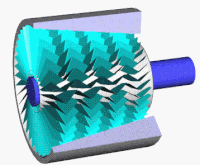
Photo from wikipedia
Abstract Instability initiated by rotating stall and surge limits the normal operating range of compressors, and seriously deteriorates the efficiency of gas-turbines. Partial surge is a new type of instability… Click to show full abstract
Abstract Instability initiated by rotating stall and surge limits the normal operating range of compressors, and seriously deteriorates the efficiency of gas-turbines. Partial surge is a new type of instability inception observed in a transonic axial flow compressor; it occurs in the form of axisymmetric low-frequency disturbances localized in the hub region and finally grows into rotating stall. For energy saving purposes, it is necessary to enhance the operating margin or stall margin of compressors. In this paper, a new design of casing treatment (axisymmetric arc-shaped slot casing treatment) is investigated to enhance the stall margin of a transonic compressor whose instability is initiated by partial surge. Both compressor performance and instability evolution before and after treatment are analyzed. The stall margin is successfully enhanced by 19.88% with the casing treatment, but the total pressure ratio only drops by 0.3% and the adiabatic efficiency does not quite change (increases by 0.15%), compared with the original solid wall case. The results of instability evolution present that partial surge occurs at nearly the same mass flow rate as the stall point of the solid wall case. As the compressor is further throttled, partial surge disappears. Then, rotating stall cells suddenly appear and trigger the formation of partial surge. In the presence of rotating stall cells and partial surge, the compressor suddenly and substantially turns into the final instability (substantial drop of compressor performance). The reasons for why the stall margin can be enhanced with this casing treatment are discussed, and the functions of the casing treatment are also discussed.
Journal Title: Aerospace Science and Technology
Year Published: 2017
Link to full text (if available)
Share on Social Media: Sign Up to like & get
recommendations!